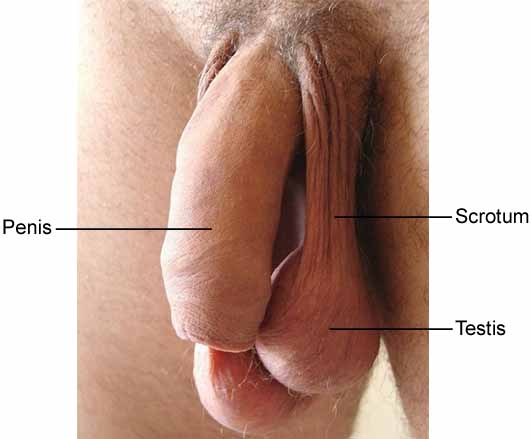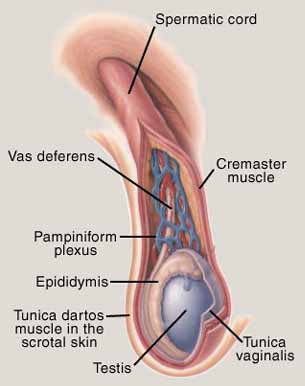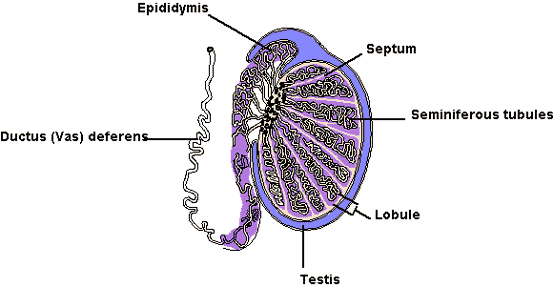Scrotum, Testes, Seminiferous Tubules, and Epididymis
The scrotum (scrotal sac) is a loose pouch of skin that contains the testicles (testes) and hangs directly underneath the penis. The scrotal sac consists of two layers, outermost layer and muscular layer. The outermost layer is thin skins covering that appear darker than body’s skin. The second layer is known as tunica dartos consists of smooth muscle fibers and fibrous tissues.
The testicle (testis) is enclosed within the scrotum and suspended by spermatic cord. The spermatic cord contains vas deferens, nerves, blood vessels, and muscle fibers that move the testicle (testis) upward or downward within the scrotal sac. The testicles (testes) are not attached to the scrotal sac and the expansion or contraction of tunica dartos muscles allow the testicles to move upward or downward.

The scrotal sac is very sensitive to temperature change. The surrounding cool temperature causes tunica dartos muscle to contract moving the testicles (testes) upward towards the body’s warm temperature. The surrounding warmth temperature causes tunica dartos muscle to expand moving the testicles (testes) downward away from the body’s warm temperature.
Sexual arousal and strong emotion can have the same influence as temperature change that causes testicles (testes) to move upward or downward within the scrotal sac.

Testes (Testicles)
The testes (testicles) are responsible for producing sperm and testosterone (male sex hormone). Normally the testes is within the scrotal sac at birth and descended by age one. In some cases a condition known as cryptorchidism occurs which prevent testes descend from the abdomen.
When testes fail to descend by age one the chances for future descend is very unlikely to take place. This is crucial because sperm production take place when scrotum temperature is around 35 to 36 degrees Celsius. The normal body temperature is around 37 degrees Celsius and in the case of fail descend the body temperature is too high for normal sperm production.

Cryptorchidism may cause male infertility and increased the risk of developing hernia. Cryptorchidism can be treated with surgery or hormonal treatment.
The testes are usually asymmetrical with the left testis hanging lower than the right testis. The testes can be affected by several diseases such as cancer and STDs. Understanding many symptoms that affect the testes are the best method for early detection and preventing the diseases.
Seminiferous Tubules
The seminiferous tubules are tiny twisted tubes in the testes that produce sperm. Sperm are produce after puberty and men continue to produce sperm until death. Sperm production began to slow down as men become older. The interstitial cells located between seminiferous tubules are responsible for producing and releasing androgen (male sex hormone) into the bloodstream.
Epididymis
The epididymis is a storage chamber for sperm that move from
seminiferous tubules to epididymis in which sperm maturation occurs.
Return from Scrotum to Male Sexual Anatomy
Return to Homepage Self Help Sexuality
Most Popular
Erotica Sex Stories That Will Make Your Cock Dripping Wet
Erotic Stories That Will Make Your Cock Very Wet & Sticky
Cum Stories That Will Make You Rock Hard & Horny
Masturbation Stories That Will Make You Throbbing Really Hard
Sex Stories That Will Make You Really Hard & Horny
Hot Sex Story That Will Make You Really Stiff & Hard
Group Sex Stories That Will Make You Very Hard & Wet
Recent Sex Stories Updated For Your Pleasure